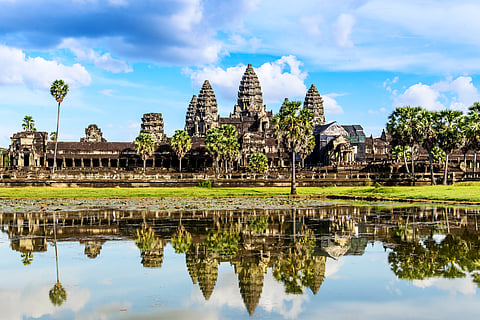

ISTOCK
In the heart of Cambodia lies one of the most breathtaking wonders of the ancient world — Angkor. Sprawling across forests and fields, this vast complex of temples was once the centre of a mighty empire that ruled much of Southeast Asia. Today, it's a silent city of stone carvings, mysterious towers, and stories waiting to be discovered.
At the heart of it all is Angkor Wat — the largest religious monument in the world. Built in the early 12th century, it was originally a Hindu temple dedicated to the god Vishnu. Over time, it became a Buddhist temple and remains one today. Unlike many other ancient sites, Angkor Wat was never completely abandoned. Monks continued to live and pray there even after the Khmer Empire declined.
What makes Angkor Wat so special isn't just its size — it's the detail. Every wall, every doorway, and every pillar is covered in carvings. These tell stories of gods, battles, kings, and everyday life. From a distance, the five towers of the temple look like lotus buds reaching toward the sky. At sunrise, when the first light hits the stone, the temple seems to glow with golden magic — a view that visitors from around the world come to witness.
But Angkor Wat is just one part of the Angkor Archaeological Park. There are over a thousand temples, from tiny ruins hidden in the jungle to grand structures like Bayon and Ta Prohm. Bayon, known for its many stone faces smiling down from towers, stands at the centre of Angkor Thom, the old royal city. Each face is believed to represent the wise and powerful King Jayavarman VII, who built the temple.
Ta Prohm, meanwhile, is a place where nature and history are tangled together. Giant tree roots wrap around temple walls and push through stones. This temple has become famous not only for its haunting beauty but also because it featured in a Hollywood movie — Tomb Raider, starring Angelina Jolie.
The Angkor Empire, also called the Khmer Empire, began in the 9th century and lasted for over 600 years. At its peak, it was one of the most advanced civilisations in the world, with grand buildings, an efficient water system, and a population of nearly a million people — more than many cities today. Its engineers built huge reservoirs and canals to manage water for farming, which allowed the kingdom to thrive even in dry seasons.
But like many great empires, Angkor eventually declined. Historians believe it may have been due to a mix of reasons — climate change, invasions, and shifting trade routes. By the 15th century, many of the temples had been left to the jungle. For centuries, the site was known mostly to locals. In the 19th century, European explorers brought news of Angkor to the outside world, sparking global fascination.
Today, Angkor is a UNESCO World Heritage Site and a symbol of Cambodia's rich history. Tourists, archaeologists, and conservationists visit not just to admire the beauty, but to study and protect the ancient structures. Local communities are also involved in preserving their heritage, as tourism plays a big part in Cambodia’s economy.
Visiting Angkor is like stepping into a storybook. The silence inside the temple corridors, the calls of tropical birds, and the smell of moss-covered stone create a world far removed from modern life. You don't need to be an archaeologist to appreciate its wonder — all it takes is curiosity.
If you are interested in architecture, mythology, or nature, Angkor is a treasure trove. You’ll find scenes from the Ramayana and Mahabharata carved into temple walls, legends of monkey kings and demon armies, and water systems that show how advanced this ancient city truly was. The stones may be old, but the stories are alive.
And here’s the most amazing part — Angkor still holds secrets. New discoveries are made using technology like ground-penetrating radar and satellite images, revealing buried roads and buildings hidden beneath the forest floor. It’s a reminder that history isn’t just something you read in textbooks — it’s something people are still uncovering, piece by piece.
Temples of Angkor weren't always hidden
When European explorers “discovered” Angkor in the 1800s, local Cambodians had never lost sight of it — it was still a place of worship.
Angkor Wat faces west — unlike most temples
Most temples face east (toward the sunrise), but Angkor Wat faces west. Some believe it was meant to be a funerary temple, facing the setting sun.
Largest religious structure in the world
Covering over 160 hectares, Angkor Wat is bigger than Vatican City!
Advanced water management system
Angkor had huge reservoirs, canals, and moats to manage floods and support farming — centuries before modern plumbing.
Carvings include over 1,800 dancers
The walls of Angkor Wat feature hundreds of carved apsaras (celestial dancers), each with unique hairstyles and jewellery.
Some towers were aligned with stars
Researchers found that parts of Angkor Wat may have been designed to reflect star patterns — especially the constellation Draco, suggesting a blend of architecture and astronomy.
The city once supported over 750,000 people
At its peak in the 12th century, Angkor was one of the largest cities in the world. It had more people than most European capitals of the time.
Massive drought and floods may have triggered its fall
Climate experts believe long droughts followed by intense flooding damaged Angkor’s water systems, leading to a gradual decline.
ISTOCK
Built without cement or glue
The stones of Angkor were stacked so precisely that they stay together without any binding materials — just clever engineering.
Angkor Wat appears on Cambodia’s national flag
It’s one of the few national flags in the world to feature a building — a sign of deep cultural pride.